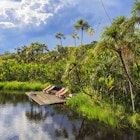

The second-highest capital in the world (after La Paz, Bolivia), Quito is a lovely Andean city with an exquisite colonial centre packed with architectural treasures. Wandering the Unesco-listed centro histórico (aka old town') is pure sensory overload.
Picturesque plazas, baroque 17th-century cathedrals and the snow-covered peaks beyond form a backdrop to a vibrant city in motion: indigenous in traditional garb and bowler hats mingle with mestizos amid the sing-song voices of street vendors, newspaper sellers and shoeshine boys, while the scent of Andean cooking spills out of open-sided restaurants and food stalls.
Rise early for a stroll through old town's cobbled streets, which are sprinkled with some of the finest colonial churches in the Americas. Not to be missed is 18th-century La Merced, with its fascinating artwork, including paintings showing volcanoes erupting over colonial Quito. Nearby the jaw-dropping Compañía de Jesús church was 160 years in the making, with a dramatic gilded interior, complete with Moorish elements and perfect symmetry (right down to the trompe l'oeil staircase painted in the rear). It's widely considered Ecuador's most beautiful building.

Have a rest in the Plaza Grande, the heart of Quito's old town. Always vibrant, this is a fine place to take the pulse of the city and catch your breath - and at 2850m elevation, Quito may make you feel a little breathless. Ringing the plaza are historic buildings: to the east stands the Palacio del Gobierno where the president works. Free tours are given (some in English) throughout the day.
To the south is Quito's somewhat austere main cathedral, a 16th-century building with a glazed ceramic roof and belltower. Although not as ornate as many of Quito's other churches, it's worth peering inside for a look at intriguing works from the Quito School (indigenous artists trained by Europeans working from the 16th to the 18th centuries). Don't miss the painting of the Last Supper with Christ and his disciples feasting on cuy (roast guinea pig), chicha (a fermented corn drink) and humitas (corn dumplings).

Opposite the church is the colonnaded Palacio Arzobispal, the former seat of Quito's archbishop. Today the massive building houses restaurants, shops and cafes scattered around an enticing fountain courtyard. A great place to stop for lunch is on the upper level. Hasta la Vuelta Señor serves traditional Andean dishes including ceviche, locro de papa (potato soup with avocado and cheese) and seco de chivo (goat stew). You can sit on the balcony overlooking the enclosed courtyard.
In the afternoon, catch a taxi over to the west side of town, for a ride on the teleferiqo, an enclosed gondola that whisks visitors 2.5km up the slopes of Volcán Pichincha to the top of Cruz Loma. At the 4100m summit, you'll have fantastic views – weather cooperating – over the city and its mountainous landscape beyond.

As evening arrives, reserve a table at Octava de Corpus (octavadecorpus.com), a restaurant secreted inside a colonial home, with an antique- and artwork-filled dining room, a gregarious host and superb Ecuadorian dishes. The wine cellar is among the country's largest.
Afterwards, stick around the neighbourhood for drinks. The aptly named Vista Hermosa (Beautiful View) (vistahermosa.ec) delivers the goods from its rooftop terrace, with 360-degree views over the old town. There's live music on weekends.
Practicalities
Ecuador's official currency is the US dollar. Aeropuerto Internacional Mariscal Sucre is located 40km east of Quito's historic district. A taxi from there is around US$24 to US$26. The old town offers some excellent accommodations, including the palatial Plaza Grande (plazagrandequito.com), with doubles from US$550. Casa San Marcos (casasanmarcos.com) is a small boutique guesthouse in a 17th-century mansion, with antique-filled heritage rooms from $170.
This article was first published in June 2012 and updated in September 2015.
The second-highest capital in the world (after La Paz, Bolivia), Quito is a lovely Andean city with an exquisite colonial centre packed with architectural treasures. Wandering the Unesco-listed centro histórico (aka old town') is pure sensory overload. Picturesque plazas, baroque 17th-century cathedrals and the snow-covered peaks beyond form a backdrop to a vibrant city in motion: indigenous in traditional garb and bowler hats mingle with mestizos amid the sing-song voices of street vendors, newspaper sellers and shoeshine boys, while the scent of Andean cooking spills out of open-sided restaurants and food stalls.
Rise early for a stroll through old town's cobbled streets, which are sprinkled with some of the finest colonial churches in the Americas. Not to be missed is 18th-century La Merced, with its fascinating artwork, including paintings showing volcanoes erupting over colonial Quito. Nearby the jaw-dropping Compañía de Jesús church was 160 years in the making, with a dramatic gilded interior, complete with Moorish elements and perfect symmetry (right down to the trompe l'oeil staircase painted in the rear). It's widely considered Ecuador's most beautiful building.
Have a rest in the Plaza Grande, the heart of Quito's old town. Always vibrant, this is a fine place to take the pulse of the city and catch your breath - and at 2850m elevation, Quito may make you feel a little breathless. Ringing the plaza are historic buildings: to the east stands the Palacio del Gobierno where the president works. Free tours are given (some in English) throughout the day.
To the south is Quito's somewhat austere main cathedral, a 16th-century building with a glazed ceramic roof and belltower. Although not as ornate as many of Quito's other churches, it's worth peering inside for a look at intriguing works from the Quito School (indigenous artists trained by Europeans working from the 16th to the 18th centuries).Don't miss the painting of the Last Supper with Christ and his disciples feasting on cuy (roast guinea pig), chicha (a fermented corn drink) and humitas (corn dumplings).
Opposite the church is the colonnaded Palacio Arzobispal, the former seat of Quito's archbishop. Today the massive building houses restaurants, shops and cafes scattered around an enticing fountain courtyard. A great place to stop for lunch is on the upper level. Hasta la Vuelta Señor serves traditional Andean dishes including ceviche, locro de papa (potato soup with avocado and cheese) and seco de chivo (goat stew). You can sit on the balcony overlooking the enclosed courtyard.
In the afternoon, catch a taxi over to the west side of town, for a ride on the teleferiqo, an enclosed gondola that whisks visitors 2.5km up the slopes of Volcán Pichincha to the top of Cruz Loma. At the 4100m summit, you'll have fantastic views – weather cooperating – over the city and its mountainous landscape beyond.
As evening arrives, reserve a table at Octava de Corpus (www.octavadecorpus.com), a restaurant secreted inside a colonial home, with an antique- and artwork-filled dining room, a gregarious host and superb Ecuadorian dishes. The wine cellar is among the country's largest.
Afterwards, stick around the neighbourhood for drinks. The aptly named Vista Hermosa (Beautiful View) delivers the goods from its rooftop terrace, with 360-degree views over the old town. There's live music on weekends.
Practicalities
Ecuador's official currency is the US dollar. Aeropuerto Internacional Mariscal Sucre is located 10km north of Quito's historic district. A taxi from there is around US$8 to
The second-highest capital in the world (after La Paz, Bolivia), Quito is a lovely Andean city with an exquisite colonial centre packed with architectural treasures. Wandering the Unesco-listed centro histórico (aka old town') is pure sensory overload. Picturesque plazas, baroque 17th-century cathedrals and the snow-covered peaks beyond form a backdrop to a vibrant city in motion: indigenous in traditional garb and bowler hats mingle with mestizos amid the sing-song voices of street vendors, newspaper sellers and shoeshine boys, while the scent of Andean cooking spills out of open-sided restaurants and food stalls.
Rise early for a stroll through old town's cobbled streets, which are sprinkled with some of the finest colonial churches in the Americas. Not to be missed is 18th-century La Merced, with its fascinating artwork, including paintings showing volcanoes erupting over colonial Quito. Nearby the jaw-dropping Compañía de Jesús church was 160 years in the making, with a dramatic gilded interior, complete with Moorish elements and perfect symmetry (right down to the trompe l'oeil staircase painted in the rear). It's widely considered Ecuador's most beautiful building.
Have a rest in the Plaza Grande, the heart of Quito's old town. Always vibrant, this is a fine place to take the pulse of the city and catch your breath - and at 2850m elevation, Quito may make you feel a little breathless. Ringing the plaza are historic buildings: to the east stands the Palacio del Gobierno where the president works. Free tours are given (some in English) throughout the day.
To the south is Quito's somewhat austere main cathedral, a 16th-century building with a glazed ceramic roof and belltower. Although not as ornate as many of Quito's other churches, it's worth peering inside for a look at intriguing works from the Quito School (indigenous artists trained by Europeans working from the 16th to the 18th centuries). Don't miss the painting of the Last Supper with Christ and his disciples feasting on cuy (roast guinea pig), chicha (a fermented corn drink) and humitas (corn dumplings).
Opposite the church is the colonnaded Palacio Arzobispal, the former seat of Quito's archbishop. Today the massive building houses restaurants, shops and cafes scattered around an enticing fountain courtyard. A great place to stop for lunch is on the upper level. Hasta la Vuelta Señor serves traditional Andean dishes including ceviche, locro de papa (potato soup with avocado and cheese) and seco de chivo (goat stew). You can sit on the balcony overlooking the enclosed courtyard.
In the afternoon, catch a taxi over to the west side of town, for a ride on the teleferiqo, an enclosed gondola that whisks visitors 2.5km up the slopes of Volcán Pichincha to the top of Cruz Loma. At the 4100m summit, you'll have fantastic views – weather cooperating – over the city and its mountainous landscape beyond.
As evening arrives, reserve a table at Octava de Corpus (www.octavadecorpus.com), a restaurant secreted inside a colonial home, with an antique- and artwork-filled dining room, a gregarious host and superb Ecuadorian dishes. The wine cellar is among the country's largest.
Afterwards, stick around the neighbourhood for drinks. The aptly named Vista Hermosa (Beautiful View) delivers the goods from its rooftop terrace, with 360-degree views over the old town. There's live music on weekends.
Practicalities
Ecuador's official currency is the US dollar. Aeropuerto Internacional Mariscal Sucre is located 10km north of Quito's historic district. A taxi from there is around US$8 to US$10. Currently under construction, a new airport 25km east of downtown is scheduled to open in 2012. The old town offers some excellent accommodations, including the palatial Plaza Grande (www.plazagrandequito.com), with doubles from US$550. Casa San Marcos (www.casasanmarcos.com) is a small boutique guesthouse in a 17th-century mansion, with antique-filled heritage rooms from $120.
Regis St. Louis is the author of the Lonely Planet Ecuador guide.
US$10. Currently under construction, a new airport 25km east of downtown is scheduled to open in 2012. The old town offers some excellent accommodations, including the palatial Plaza Grande (www.plazagrandequito.com), with doubles from US$550. Casa San Marcos (www.casasanmarcos.com) is a small boutique guesthouse in a 17th-century mansion, with antique-filled heritage rooms from $120.
Regis St. Louis is the author of the Lonely Planet Ecuador guide.
Explore related stories







 BeachesUltimate travel list: Lonely Planet's top sights in the world (11 to 20)
BeachesUltimate travel list: Lonely Planet's top sights in the world (11 to 20)Aug 17, 2015 • 7 min read











